I started by designing a stencil. You can do this by hand - just draw the picture your want to carve and scale it by using a photocopier so it is the right size for your pumpkin. I used a computer with Adobe Illustrator, which, admittedly, is overkill (although I used Illustrator 10, which is still overkill). Using Illustrator, I drew up the design and scaled it and printed onto letter size paper (8.5 x 11 in.).
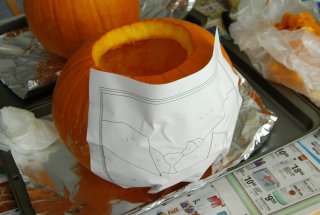 I placed the stencil on the pumpkin and secured it in place with tape. Some portions of the stencil needed to be cut or torn or folded over just a bit to get it to be flush on the curved surface. Once the stencil is secured, I used a thumbtack or pushpin to punch little holes along the lines. I spaced the pushpin holes about 1/4 in. apart unless there was great detail or an intersection of lines. Then I'd add additional holes as necessary.
I placed the stencil on the pumpkin and secured it in place with tape. Some portions of the stencil needed to be cut or torn or folded over just a bit to get it to be flush on the curved surface. Once the stencil is secured, I used a thumbtack or pushpin to punch little holes along the lines. I spaced the pushpin holes about 1/4 in. apart unless there was great detail or an intersection of lines. Then I'd add additional holes as necessary.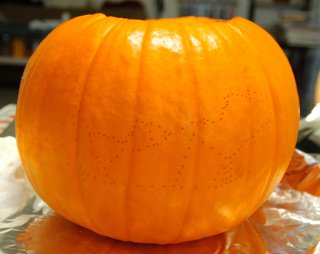 I removed the stencil and now I can still see the general pattern on my pumpkin because I have enough little holes to form the pattern. I saved the stencil for reference and even marked it up with notes concerning how deep to cut each region.
I removed the stencil and now I can still see the general pattern on my pumpkin because I have enough little holes to form the pattern. I saved the stencil for reference and even marked it up with notes concerning how deep to cut each region.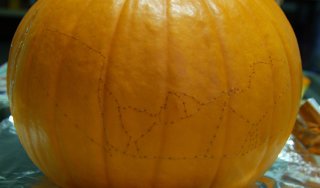 Using a paring knife, I connected the dots.
Using a paring knife, I connected the dots.Related Articles
Using the calipers, I measured the needed depth on a slim screwdriver and taped off the head of the screw driver at that depth. I then plunged the screwdriver into the pumpkin along each cut line so it would be cut to the appropriate depth. If the screwdriver didn't go in easily, I took the paring knife and cut a parallel line next to the line I was trying to attack. When I cut a parallel line less than a millimeter away, it was easy to remove the sliver by tilting the blade of the knife. Then I continued to plunge the screwdriver around the perimeter of the shape I was working on. Once the perimeter depth was marked, I used the paring knife to cut from inside the region out to the sides, lifting pumpkin rind off until I achieved a somewhat uniform depth. Occasionally, I scraped with the screwdriver in harder to reach areas.
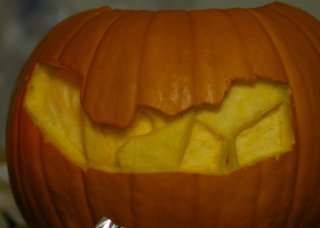 Working segment by segment (and constantly reapplying tape to the screwdriver at different depths), I managed to carve out the entire scene in a couple hours.
Working segment by segment (and constantly reapplying tape to the screwdriver at different depths), I managed to carve out the entire scene in a couple hours.I then looked into how to preserve the pumpkin. With that much exposed flesh, it was sure to lose moisture and begin to wilt in no time. I had read that petroleum jelly can help seal in the moisture and protect the pumpkin, I lathered petroleum jelly over all the exposed surfaces inside and out.
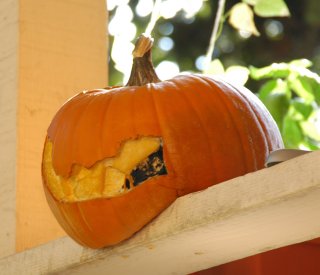 Less than six days later, this is what my pumpkin looked like. The rind was so soft that when I touched it, I left finger marks in the skin of the pumpkin.
Less than six days later, this is what my pumpkin looked like. The rind was so soft that when I touched it, I left finger marks in the skin of the pumpkin.Don't leave the pumpkin out where it can be exposed to the sun. It starts to bake a bit and that softens up the pumpkin. The pumpkin also begin to rot faster and promote the growth of mold on the surface. I don't know if the petroleum jelly helped, but I do know that the sun didn't help.
Related Articles

http://www.extremepumpkins.com/
There are two pictures of the design lit in the first article.